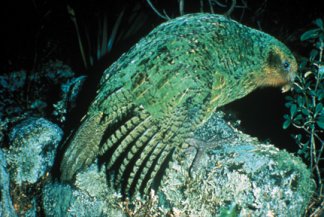Polly shouldn’t get a cracker
When female kakapo parrots go on a diet, they produce fewer male chicks.
It’s a boy! That’s the sort of news that biologists working to save endangered kakapo parrots in New Zealand probably aren’t happy to hear all the time.
 |
|
The kakapo parrot, which can weigh more than 1.5 kilograms, forages at night. The birds can live about 60 years.
|
| D. Merton/VIREO |
The population of kakapo parrots currently numbers about 86 birds. Scientists have been trying to find ways to increase the number of these hefty, green, flightless creatures.
About 5 years ago, conservationists noticed that females that they were feeding had far fewer female than male offspring. Fewer females mean fewer eggs in the future. But with such a small population to start with, the parrots need all the egg-laying females they can get.
To even out the number of male and female chicks, researchers found that they had to put some of the mama parrots on a diet.
In the wild, kakapos rummage around for plants from which they suck juices. Some years, they get extra helpings of tiny orange fruits from New Zealand’s rimu trees. In those fruit-filled years, the kakapos lay more eggs than they do in years when food is scarce.
Kakapos in captivity used to get extra treats as well. Their keepers fattened them up so the birds would produce babies with a better chance of survival. However, although the chicks were healthier, most of them were male.
Biologists suspected that the problem was related to the way kakapos find a mate. It isn’t easy for a male kakapo to attract a female. In the summer, male parrots carefully clear dirt patches and call out to potential partners for hours at night. Female parrots flock to the most impressive males. The other males are left completely out of the game.
According to evolutionary theory, well-fed mother parrots would have more sons because healthy males would have a better chance of catching the attention of female parrots. In contrast, scrawny sons would have a harder time attracting females, so under-fed mother parrots would have more daughters.
To test the idea, people breeding kakapos cut the chubbiest females’ menu. When the dieting parrots had chicks, 9 were male and 10 were female. Among the females that were already lean, the birds produced 7 male eggs and 9 female ones.
So, to ensure that there are going to be plenty of kakapos someday, perhaps these New Zealand birds should lay off of those yummy treats for a while. And, indeed, the population is already starting to recover from a shortage of female chicks.—K. Ramsayer
Going Deeper:
Milius, Susan. 2006. Dieting to save a species: Mother parrots that eat less avoid excess of sons. Science News 169(Jan. 21):36. Available at http://www.sciencenews.org/articles/20060121/fob3.asp .
You can learn more about the kakapo at www.kakapo.net/en/ (Kakapo.net).
